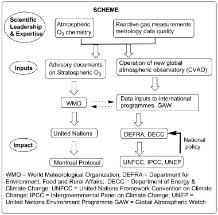Ozone-depleting substances in the atmosphere
Ozone in the upper atmosphere (stratosphere) protects humankind and its crops from harmful ultraviolet radiation. Stratospheric ozone destruction resulting from human activities is caused mainly by long-lived chlorine-containing and bromine-containing molecules. The 1987 Montreal Protocol and its subsequent amendments have resulted in the phasing-out of the production of many of the substances that deplete the ozone layer. The protocol has prevented millions of cases of skin cancer deaths and cataracts, and has also reduced emissions of greenhouse gases very substantially. Former UN Secretary-General Kofi Annan called it in 2003 Perhaps the single most successful international agreement to date.

York researchers led by Peter Bernath and Lucy Carpenter strengthened the science underlying the Montreal Protocol. Bernath used the Atmospheric Chemistry Experiment (ACE) satellite (ace.uwaterloo.ca) to monitor the decay of halogen-containing molecules in the stratosphere and to determine their atmospheric lifetimes much more precisely than previously. Carpenter determined that oceans represent a vast reservoir of organic compounds incorporating bromine, which are released to the air and impact significantly on ozone destruction. These results help to provide confidence in the effectiveness of the protocol and also help to close any gaps between observations and predictions of ozone recovery. The research programme also achieved long-term impacts through the construction of an observatory in Cape Verde Islands. The observatory is now supported as a permanent UK contribution to the Global Atmospheric Watch programme (wmo.int/gaw). The measurements from Cape Verde demonstrated the value of long-term monitoring of the tropical atmosphere. The observatory now helps the UK meet its United Nations obligations on climate change detection and alerts the UK government to changes in the Atlantic atmosphere.
The 2010 Ozone Assessment of the United Nations Environmental Programme and two earlier reports highlights the original research undertaken in York. Bernath and Carpenter also both contributed substantially as reviewers of the 2010 report and members of the 2010 Scientific Assessment Panel of the Montreal Protocol.
